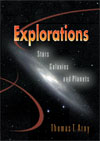The Moon is our nearest neighbor in space, a natural satellite orbiting the
Earth. It is the frontier of direct human exploration, an outpost that we reached
more than a quarter century ago but from which we have since drawn back. But
despite our retreat from its surface, the Moon remains of great interest to
astronomers. Although originally the Moon was molten, its small mass and radius
have made it difficult for it to either generate or retain any appreciable internal
heat. It is therefore a dead world, with neither plate tectonic nor volcanic
activity. That inactivity when coupled with the Moon's lack of atmosphere means
that its surface features are essentially unaltered since its youth. But the
Moon has not always been quiescent. Shortly after its formation, it was pelted
with a hail of rocky fragments whose size ranged up to 200 kilometers (about
100 miles) in diameter. The small fragments made craters, and the big fragments
made huge basins. The basins subsequently flooded with lava (long since congealed)
to create several dark, nearly circular plains easily visible to the naked eye.
The Earth probably once bore such features, but erosion and plate motions have
erased them. On the Moon's windless, rainless, airless surface, however, they
remain--a record of events in the early Solar System that gives clues not only
to the Moon's birth but to that of the Solar System as well. In this chapter, we will describe the Moon's surface and why astronomers
believe so many of its features were carved by impact. We will see that lunar
rocks differ significantly from terrestrial ones and how they point to the Moon's
having been born in a cataclysmic event early in the Earth's history. We will
also discuss how the Moon affects Earth today through tides and eclipses. But
we will begin with a short physical description of the Moon to help us visualize
this nearest world. |



 2002 McGraw-Hill Higher Education
2002 McGraw-Hill Higher Education

 2002 McGraw-Hill Higher Education
2002 McGraw-Hill Higher Education